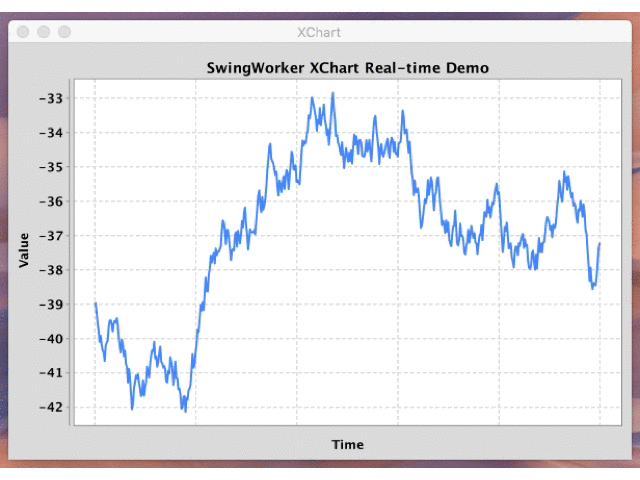Real-time graphing in Java
In order to get your CPU well below 100% and allow your GUI to remain responsive, you have to throttle back your chart updating rate. A maximum update rate of around 24 frames per second makes sense for a real-time chart; any faster is more or less indistinguishable anyway. If your data is coming in faster than that rate, you just need to buffer it in the background and update your chart in the foreground at your desired update rate. In the following example, I use XChart along with a SwingWorker background thread. The data capture is simulated at a rate of one per every 5 ms and the chart is updated at 24 frames per second. This concept should work with JFreeCharts or any other charting library as well with slight modification. Disclaimer: I'm the lead developer of XChart.
import java.util.LinkedList;
import java.util.List;
import javax.swing.SwingWorker;
import org.knowm.xchart.QuickChart;
import org.knowm.xchart.SwingWrapper;
import org.knowm.xchart.XYChart;
/**
* Creates a real-time chart using SwingWorker
*/
public class SwingWorkerRealTime {
MySwingWorker mySwingWorker;
SwingWrapper<XYChart> sw;
XYChart chart;
public static void main(String[] args) throws Exception {
SwingWorkerRealTime swingWorkerRealTime = new SwingWorkerRealTime();
swingWorkerRealTime.go();
}
private void go() {
// Create Chart
chart = QuickChart.getChart("SwingWorker XChart Real-time Demo", "Time", "Value", "randomWalk", new double[] { 0 }, new double[] { 0 });
chart.getStyler().setLegendVisible(false);
chart.getStyler().setXAxisTicksVisible(false);
// Show it
sw = new SwingWrapper<XYChart>(chart);
sw.displayChart();
mySwingWorker = new MySwingWorker();
mySwingWorker.execute();
}
private class MySwingWorker extends SwingWorker<Boolean, double[]> {
LinkedList<Double> fifo = new LinkedList<Double>();
public MySwingWorker() {
fifo.add(0.0);
}
@Override
protected Boolean doInBackground() throws Exception {
while (!isCancelled()) {
fifo.add(fifo.get(fifo.size() - 1) + Math.random() - .5);
if (fifo.size() > 500) {
fifo.removeFirst();
}
double[] array = new double[fifo.size()];
for (int i = 0; i < fifo.size(); i++) {
array[i] = fifo.get(i);
}
publish(array);
try {
Thread.sleep(5);
} catch (InterruptedException e) {
// eat it. caught when interrupt is called
System.out.println("MySwingWorker shut down.");
}
}
return true;
}
@Override
protected void process(List<double[]> chunks) {
System.out.println("number of chunks: " + chunks.size());
double[] mostRecentDataSet = chunks.get(chunks.size() - 1);
chart.updateXYSeries("randomWalk", null, mostRecentDataSet, null);
sw.repaintChart();
long start = System.currentTimeMillis();
long duration = System.currentTimeMillis() - start;
try {
Thread.sleep(40 - duration); // 40 ms ==> 25fps
// Thread.sleep(400 - duration); // 40 ms ==> 2.5fps
} catch (InterruptedException e) {
}
}
}
}

If your variable is updating that fast, there's no point in updating a chart every time.
Have you thought about buffering the variable changes, and refreshing the chart on a different thread, say, every 5s ? You should find that JFreeChart can handle such update rates well.
Since JFreeChart is a normal desktop library, you can integrate it with a standard Swing application very easily. Or, you can use it to chart via a web application (by rendering to a JPEG/PNG etc. JFreeChart can generate image maps automatically as well, so you can use mouseovers etc.)